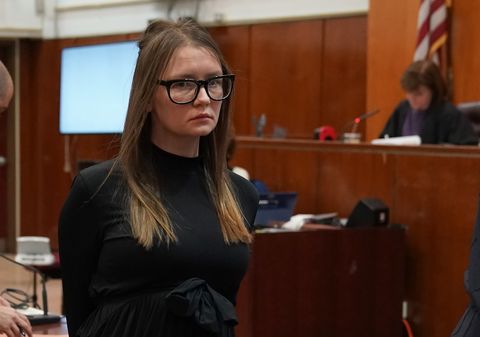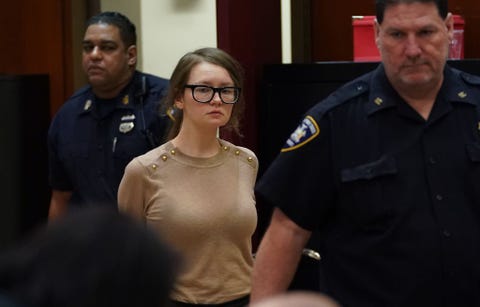The following contains spoilers for Inventing Anna.
When Anna Sorokin, known to those she swindled as Anna Delvey, spoke with New York Magazine from Rikers Island prison in late 2017, she disavowed her public epithets. New York media had called her a “wannabe socialite” and a “greedy idiot”—a fraud who rubbed shoulders with the city’s rich and powerful simply to go shopping. Sorokin insisted instead that she was trying to build something, a business. “I had dinners, but they were work dinners,” she told writer Jessica Pressler. “I wanted to be taken seriously.”
Serious or not, Sorokin’s story soon became entertainment fodder; it is now the basis of Inventing Anna, Netflix’s latest true crime drama series.
The opening moments of the series dramatizes those first Rikers Island meetings between Sorokin and Pressler—whose character is named Vivian Kent in the series and works for Manhattan (the series’ stand-in for New York Magazine). Sorokin was then awaiting trial for charges of theft of service and grand larceny. (As in the series, Sorokin rejected a plea bargain shortly thereafter.)
The New York story ran almost a year before Sorokin went to trial. It includes interviews with New York acquaintances of Sorokin, several of whom had lent her money at one time, assuming the German heiress and trust fund kid Sorokin presented herself as would be able to pay them back. For nearly an entire year, Delvey led them on. She was arrested in October 2017.
Because the article relies mainly on accounts given by Sorokin’s acquaintances, and because the interviews with Sorokin—including phone calls and “several” visits to Rikers over the course of three months—occurred before trial, the details about her life remain uncertain.
Perhaps because the series also relies on such reporting, an opening title screen makes clear the veracity of the drama: “This whole story is completely true, except for the parts that are totally made up.” That’s certainly one way to avoid defamation lawsuits.
There are, however, many real events depicted in the series, and while some names and identifying features have been changed, the story of Anna Sorokin/Anna Delvey—at least according to Pressler’s article—shares verisimilitude with the public accounts of those she knew.
Pressler sums up the story’s significance in the final section:
“During the course of my reporting, people kept asking: Why this girl? She wasn’t superhot, they pointed out, or super-charming; she wasn’t even very nice. How did she manage to convince an enormous amount of cool, successful people that she was something she clearly was not? Watching the Rikers guard shove Fast Company into a manila envelope, I realized what Anna had in common with the people she’d been studying in the pages of that magazine: She saw something others didn’t. Anna looked at the soul of New York and recognized that if you distract people with shiny objects, with large wads of cash, with the indicia of wealth, if you show them the money, they will be virtually unable to see anything else. And the thing was: It was so easy.”
Here’s how Sorokin fooled those around her, and what happened when she finally reached trial.
Who Is Anna Delvey?
To those she met in New York and Europe between 2013 and 2017, Anna Sorokin (using the name “Delvey”) was a German heiress, trust fund kid, and businesswoman, looking to turn the historic Church Missions House on Park Avenue into a kind of Soho House—a social club and a venue for art and culture.
While the heiress and trust fund identities we know now to be fake, Sorokin does appear to have been seriously invested in her business venture. At least, this is the argument given by Sorokin’s lawyer Todd Spodek, who in his opening statement claimed that Sorokin was not intending to commit a crime. Sorokin was merely exploiting a system in order to open doors into the New York social scene, Spodek argued. That meant Sorokin was going to “fake it until she could make it.” Spodek said Sorokin’s burrowing habits with friends and requests for bank loans was merely for her way of “buying time” before her business could take off and she could repay her debts. Sorokin was “ambitious, she was persistent and she was determined to make her business a reality,” argued Spodek.
To make her business a reality, she had to reinvent herself as the kind of wealthy socialite other wealthy socialites might believe—and invest in. And so she became Anna Delvey, the German heiress.
The identity was a ruse.
According to New York, Sorokin was born in Russia in 1991 and then moved to Germany at 16—a fact which might explain her lack of proficiency in German. (Acquaintances had noticed her lack of language skills despite her proclaimed nationality.) She did not have a trust fund, her father told New York. Sorokin dropped out of college and moved to Paris, the article goes on to report, where she interned at Purple magazine.
Sorokin came to New York and in 2016 she attempted to secure a $22 million loan in order to proceed with her private club venture. She sent multiple banks falsified documents in order to secure the loan. Prosecutors in the case then said Sorokin convinced a representative of City National Bank to help her withdraw $100,000. The money would be used as an initial payment to Fortress Investment Group, which had agreed to supply the $22 million loan.
Sorokin apparently then provided Fortress with $45,000 as they attempted to verify her assets. She withdrew from loan consideration after, using the remaining $55,000 on personal items. (Sorokin had told Fortress she would repay the $100,000 over wire transfer, but the money was never sent.)
During this time, Sorokin was accumulating debt across New York. She was staying in luxury hotels for months on end, dining at expensive Manhattan restaurants, and traveling. According to acquaintances, she was using cash to pay for almost everything, a habit that led almost everyone in her circle to believe she was indeed an heiress to some family fortune.
One particular debt brought up in court was a personal loan Sorokin received from friend Rachel Williams—in the form of $62,000 in travel expenses after Sorokin invited Williams to Morocco and had her foot the bill after her own card was declined. (Williams’ account of the incident for Vanity Fair ran just a month before the New York Magazine story.)
In a statement quoted in Time, former prosecutor Jeffrey Chabrowe explained why it was this personal debt which would be most damning:
“If this girl was just taking from banks, not only would it be harder to have a conviction, I think there would be people literally cheering for her. Like, good for her. When you’re doing it to you friend, and your friend thinks they’re being taking on a vacation of a lifetime and instead she loses a year of salary — I think that’s going to hurt [Sorokin] the most.”
Ultimately, Sorokin was arrested in October 2017 and held at Rikers Island without bail. In December, she rejected a plea bargain in which she may have seen only a few months in prison. Instead, her case went to trial and in April 2019 Sorokin was found guilty of several charges, including three counts of grand larceny.
She was sentenced to four to 12 years in prison.
Where Is Anna Delvey Now?
Sorokin served under four years in prison. She was released on good behavior in February 2021. In a subsequent interview with ABC News, Sorokin denied telling acquaintances that she was an heiress or that she had any fraudulent intent.
While Sorokin sold the rights to her story to Netflix and Shonda Rhimes, she was legally unable to profit off the sale; the money will be used to pay back her victims.
Sorokin has since been jailed once again, this time by U.S. Immigration and Customs Enforcement. She faces potential deportation.
This content is created and maintained by a third party, and imported onto this page to help users provide their email addresses. You may be able to find more information about this and similar content at piano.io




Comments are closed.